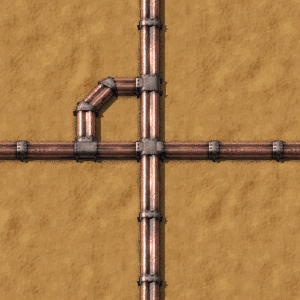Heat pipe: Difference between revisions
m formatting |
m Adjusted wording for reactor transmitting heat |
||
| Line 19: | Line 19: | ||
A nuclear reactor can also be used to transfer heat in a similar manner as a heat pipe, whether or not it's fueled. In this case, the reactor will drop the temperature by <code>1 + (P / 387) °C</code>, with P again being the power in MW going through the entity. Note that this is an approximation, the actual value measured is supposed to be 200000/517 or about 386.847. | |||
That being said, the nuclear reactor entity is also much bigger, meaning that we must compare it to 5 lines of 5 heat pipes instead of just a single one. The nuclear reactor will thus lower the temperature 5 times less with near-zero power going through it, and nearly 26 times less when approaching infinite power, compared to those lines of heat pipes. | That being said, the nuclear reactor entity is also much bigger, meaning that we must compare it to 5 lines of 5 heat pipes instead of just a single one. The nuclear reactor will thus lower the temperature 5 times less with near-zero power going through it, and nearly 26 times less when approaching infinite power, compared to those lines of heat pipes. | ||
Revision as of 11:55, 10 March 2024
| Heat pipe |
- Base game
- Space Age mod
The heat pipe can transport heat over longer distances and connect devices which produce and use heat. Currently this is limited to heat exchangers and nuclear reactors.
Heat pipes have a heat capacity of 1 MJ/°C. Thus, they can theoretically buffer 500 MJ of heat energy across their working range of 500°C to 1000°C, making them a space-efficient energy store. However, because temperature needs a drop of greater than 1 degree before it will "flow," you can't raise them all the way to 1000°C or drain them all the way to 500°C, so the practical energy capacity will depend on the layout.
As heat pipes rise in temperature, they will give off a very low-distance glow.
Heat pipe throughput
Heat pipes are acting very similarly to fluid pipes: they each hold an amount of heat energy and there is a limit to how much energy can go through each of them for a given duration.
For any heat pipe entity with one input connection on one side and one output connection on another, this entity with lower the temperature by 1 + (P / 15) °C with P being the power going through this entity expressed in MW.
Since a nuclear power plant can have at most 500°C difference between the hottest (a nuclear reactor) and coldest (a heat exchanger) points of the system, that means that we can express the maximum length of a straight line of heat pipe as 500 / (1 + P/15).
For example let's take a single nuclear reactor outputting 40MW of heat power to a single line of heat pipes. The furthest that line can go is 500 / (1 + 40/15) which is around 136 heat pipes long.
A nuclear reactor can also be used to transfer heat in a similar manner as a heat pipe, whether or not it's fueled. In this case, the reactor will drop the temperature by 1 + (P / 387) °C, with P again being the power in MW going through the entity. Note that this is an approximation, the actual value measured is supposed to be 200000/517 or about 386.847.
That being said, the nuclear reactor entity is also much bigger, meaning that we must compare it to 5 lines of 5 heat pipes instead of just a single one. The nuclear reactor will thus lower the temperature 5 times less with near-zero power going through it, and nearly 26 times less when approaching infinite power, compared to those lines of heat pipes.
As an example, a single line of 100 nuclear reactors (or 500 tiles) will only lower the temperature by about 360°C while carrying 1GW.
History
- 0.17.67:
- Heat pipes (also in reactors and heat exchangers) glow with high temperatures.
- 0.15.11:
- Changed heat transfer mechanics, prior to this heat would flow better following the order of heat pipe placement
- 0.15.0:
- Introduced
See also
